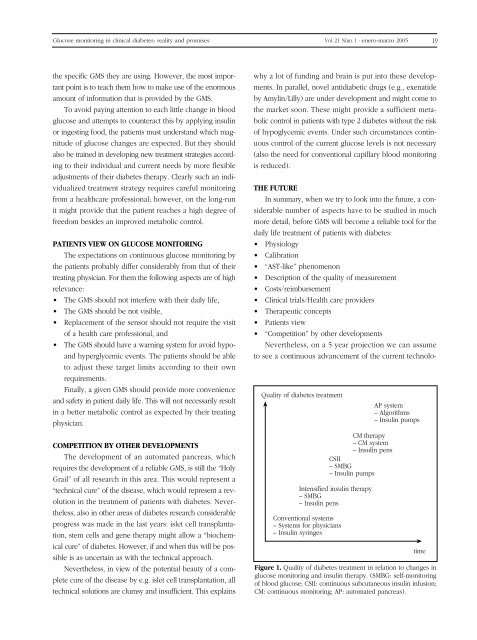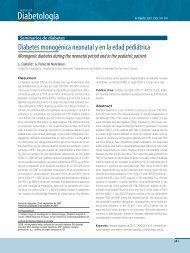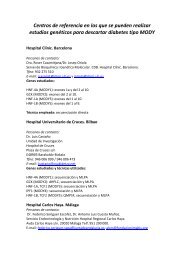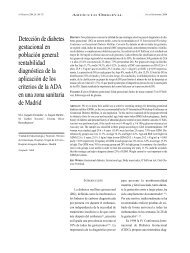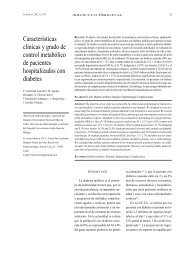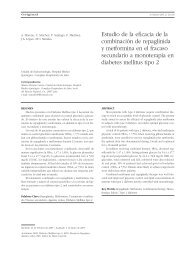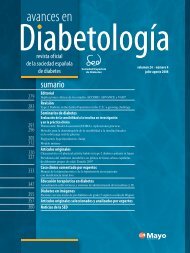18Vol. 21 Núm. 1 - <strong>en</strong>ero-marzo 2005L. HeinemannThe most plausible explanation for the AST-ph<strong>en</strong>om<strong>en</strong>onis a reduced blood flow in the upper layers of the skinat the abdom<strong>en</strong> or the arm. Up to now the AST-ph<strong>en</strong>om<strong>en</strong>onwas regar<strong>de</strong>d as an aspect that is of relevance with bloodglucose meters only. However, this is a topic which has tobe studied in relation with continuous glucose monitoringas well; un<strong>de</strong>r the circumstances of glucose monitoring systemsthis is called the “AST-like-ph<strong>en</strong>om<strong>en</strong>on” 4 . Wh<strong>en</strong> slowchanges in glucose levels in the differ<strong>en</strong>t compartm<strong>en</strong>ts takeplace, the AST-like-ph<strong>en</strong>om<strong>en</strong>on most probably has noimpact in daily life. However, it can be of high relevancewh<strong>en</strong> rapid changes in glycemia take place.Dep<strong>en</strong>ding on the specific technology used differ<strong>en</strong>ttypes of GMS might show consi<strong>de</strong>rable differ<strong>en</strong>ces in theimpact this ph<strong>en</strong>om<strong>en</strong>on has on the reliability of the displayedresults, however, our knowledge about this is verylimited. Detailed clinical-experim<strong>en</strong>tal studies with rapidchanges in glycemia are required which allow quantitative<strong>de</strong>termination of the differ<strong>en</strong>t factors that have an impact ondiffer<strong>en</strong>ces in glucose levels measured in systemic blood,peripheral blood, and interstitial fluid (may this be intra<strong>de</strong>rmalor subcutaneous).ASSESSMENT CRITERIAContinuous glucose monitoring provi<strong>de</strong>s much moreinformation (in case of a minute-to-minute measurem<strong>en</strong>t1440 values in 24 h!) than spot glucose monitoring with bloodglucose meters (maximal 10 values per day). However, thequestion is how reliable are these measurem<strong>en</strong>t? The statisticaltools <strong>de</strong>veloped over many years to <strong>de</strong>scribe the measurem<strong>en</strong>tquality of blood glucose meters are not necessarilythe optimal ones for GMS. For example, the Error gridanalysis does not only ignore time information that comesalong with the continuously recor<strong>de</strong>d glucose levels, the factthat the values are not in<strong>de</strong>p<strong>en</strong>d<strong>en</strong>tly measured values, whichis a prerequisite for a linear regression analysis, in principleban this type of analysis. Curr<strong>en</strong>tly, there is int<strong>en</strong>sive researchto <strong>de</strong>velop a<strong>de</strong>quate statistical tools for the comparison oflongitudinally registered signals of a giv<strong>en</strong> GMS with that ofa refer<strong>en</strong>ce measurem<strong>en</strong>t, may this provi<strong>de</strong> continuous measurem<strong>en</strong>tresults as well or single values from spot measurem<strong>en</strong>ts.For example, also a modified version of the ErrorGrid Analysis is now available, which was adapted for theanalysis of data collected with GMS.Up to now in most clinical-experim<strong>en</strong>tal and clinical studiesthe performance of a giv<strong>en</strong> GMS was compared to spotglucose measurem<strong>en</strong>ts performed by means of conv<strong>en</strong>tionalcapillary blood glucose measurem<strong>en</strong>ts in regular intervals.If only the pairs of corresponding values from the continuouslyrecor<strong>de</strong>d data and the refer<strong>en</strong>ce measurem<strong>en</strong>t are usedfor the statistical analysis, this requires that the vast majorityof the available data are ignored! Hopefully, novel assessm<strong>en</strong>tcriteria will allow to evaluate the performance of differ<strong>en</strong>tglucose s<strong>en</strong>sors in the same pati<strong>en</strong>t in parallel and to<strong>de</strong>scribe the quality of the measurem<strong>en</strong>t in quantitative terms(3). If such assessm<strong>en</strong>t criteria <strong>en</strong>able a better characterizationof GMS performance and were used uniformly by allmanufacturers and sci<strong>en</strong>tists assessing such systems, thiswould allow a fair comparison of the performance of differ<strong>en</strong>tsystems.CLINICAL TRIALSThe performance of GMS should be tested in a<strong>de</strong>quately<strong>de</strong>signed clinical studies. That means that not only theanalytical performance should be evaluated, but also thehandling of the system must be studied and the b<strong>en</strong>efits ing<strong>en</strong>eral of continuous glucose monitoring should be evaluated.Such clinical studies should have an appropriate study<strong>de</strong>sign, a suffici<strong>en</strong>t number of participants and suffici<strong>en</strong>t longstudy duration.In view of the costs that the introduction of GMS imposeson the healthcare system, it must be <strong>de</strong>monstrated thatthese systems helps pati<strong>en</strong>ts to improve their metabolic control,to reduce the number of blood glucose excursions (i.e,hypoglycemic ev<strong>en</strong>ts) and to increase their quality of life.Everybody would like to see such studies to be performed,however, the financial burd<strong>en</strong> of such a study (orstudies) most probably are too high for the manufacturer ofGMS; which are most oft<strong>en</strong> relatively small companies. Probablythe only chance to perform such a study is a co-fundingof several companies. The aim of such a study is notto <strong>de</strong>monstrate the pros and cons of a giv<strong>en</strong> GMS, but toinvestigate the impact of continuous glucose monitoring ondiabetes therapy in g<strong>en</strong>eral.THERAPEUTIC CONCEPTSThe availability of long-term GMS which work with a suffici<strong>en</strong>treliability in daily life in the (hopefully near) future donot simply mean that pati<strong>en</strong>ts with diabetes drop their bloodglucose meter and use these novel systems from one dayto the other. In or<strong>de</strong>r to use these systems a<strong>de</strong>quately thepati<strong>en</strong>ts (and their treating physicians) must be trained innewly <strong>de</strong>veloped educational programs about the conceptof continuous glucose monitoring and the pros and cons of
Glucose monitoring in clinical diabetes: reality and promises Vol. 21 Núm. 1 - <strong>en</strong>ero-marzo 2005 19the specific GMS they are using. However, the most importantpoint is to teach them how to make use of the <strong>en</strong>ormousamount of information that is provi<strong>de</strong>d by the GMS.To avoid paying att<strong>en</strong>tion to each little change in bloodglucose and attempts to counteract this by applying insulinor ingesting food, the pati<strong>en</strong>ts must un<strong>de</strong>rstand which magnitu<strong>de</strong>of glucose changes are expected. But they shouldalso be trained in <strong>de</strong>veloping new treatm<strong>en</strong>t strategies accordingto their individual and curr<strong>en</strong>t needs by more flexibleadjustm<strong>en</strong>ts of their diabetes therapy. Clearly such an individualizedtreatm<strong>en</strong>t strategy requires careful monitoringfrom a healthcare professional; however, on the long-runit might provi<strong>de</strong> that the pati<strong>en</strong>t reaches a high <strong>de</strong>gree offreedom besi<strong>de</strong>s an improved metabolic control.PATIENTS VIEW ON GLUCOSE MONITORINGThe expectations on continuous glucose monitoring bythe pati<strong>en</strong>ts probably differ consi<strong>de</strong>rably from that of theirtreating physician. For them the following aspects are of highrelevance:• The GMS should not interfere with their daily life,• The GMS should be not visible,• Replacem<strong>en</strong>t of the s<strong>en</strong>sor should not require the visitof a health care professional, and• The GMS should have a warning system for avoid hypoandhyperglycemic ev<strong>en</strong>ts. The pati<strong>en</strong>ts should be ableto adjust these target limits according to their ownrequirem<strong>en</strong>ts.Finally, a giv<strong>en</strong> GMS should provi<strong>de</strong> more conv<strong>en</strong>i<strong>en</strong>ceand safety in pati<strong>en</strong>t daily life. This will not necessarily resultin a better metabolic control as expected by their treatingphysician.COMPETITION BY OTHER DEVELOPMENTSThe <strong>de</strong>velopm<strong>en</strong>t of an automated pancreas, whichrequires the <strong>de</strong>velopm<strong>en</strong>t of a reliable GMS, is still the “HolyGrail” of all research in this area. This would repres<strong>en</strong>t a“technical cure” of the disease, which would repres<strong>en</strong>t a revolutionin the treatm<strong>en</strong>t of pati<strong>en</strong>ts with diabetes. Nevertheless,also in other areas of diabetes research consi<strong>de</strong>rableprogress was ma<strong>de</strong> in the last years: islet cell transplantation,stem cells and g<strong>en</strong>e therapy might allow a “biochemicalcure” of diabetes. However, if and wh<strong>en</strong> this will be possibleis as uncertain as with the technical approach.Nevertheless, in view of the pot<strong>en</strong>tial beauty of a completecure of the disease by e.g. islet cell transplantation, alltechnical solutions are clumsy and insuffici<strong>en</strong>t. This explainswhy a lot of funding and brain is put into these <strong>de</strong>velopm<strong>en</strong>ts.In parallel, novel antidiabetic drugs (e.g., ex<strong>en</strong>ati<strong>de</strong>by Amylin/Lilly) are un<strong>de</strong>r <strong>de</strong>velopm<strong>en</strong>t and might come tothe market soon. These might provi<strong>de</strong> a suffici<strong>en</strong>t metaboliccontrol in pati<strong>en</strong>ts with type 2 diabetes without the riskof hypoglycemic ev<strong>en</strong>ts. Un<strong>de</strong>r such circumstances continuouscontrol of the curr<strong>en</strong>t glucose levels is not necessary(also the need for conv<strong>en</strong>tional capillary blood monitoringis reduced).THE FUTUREIn summary, wh<strong>en</strong> we try to look into the future, a consi<strong>de</strong>rabl<strong>en</strong>umber of aspects have to be studied in muchmore <strong>de</strong>tail, before GMS will become a reliable tool for thedaily life treatm<strong>en</strong>t of pati<strong>en</strong>ts with diabetes:• Physiology• Calibration• “AST-like” ph<strong>en</strong>om<strong>en</strong>on• Description of the quality of measurem<strong>en</strong>t• Costs/reimbursem<strong>en</strong>t• Clinical trials/Health care provi<strong>de</strong>rs• Therapeutic concepts• Pati<strong>en</strong>ts view• “Competition” by other <strong>de</strong>velopm<strong>en</strong>tsNevertheless, on a 5 year projection we can assumeto see a continuous advancem<strong>en</strong>t of the curr<strong>en</strong>t technolo-Quality of diabetes treatm<strong>en</strong>tCM therapy– CM system– Insulin p<strong>en</strong>sCSII– SMBG– Insulin pumpsInt<strong>en</strong>sified insulin therapy– SMBG– Insulin p<strong>en</strong>sConv<strong>en</strong>tional systems– Systems for physicians– Insulin syringesAP system– Algorithms– Insulin pumpstimeFigure 1. Quality of diabetes treatm<strong>en</strong>t in relation to changes inglucose monitoring and insulin therapy. (SMBG: self-monitoringof blood glucose; CSII: continuous subcutaneous insulin infusion;CM: continuous monitoring; AP: automated pancreas).


